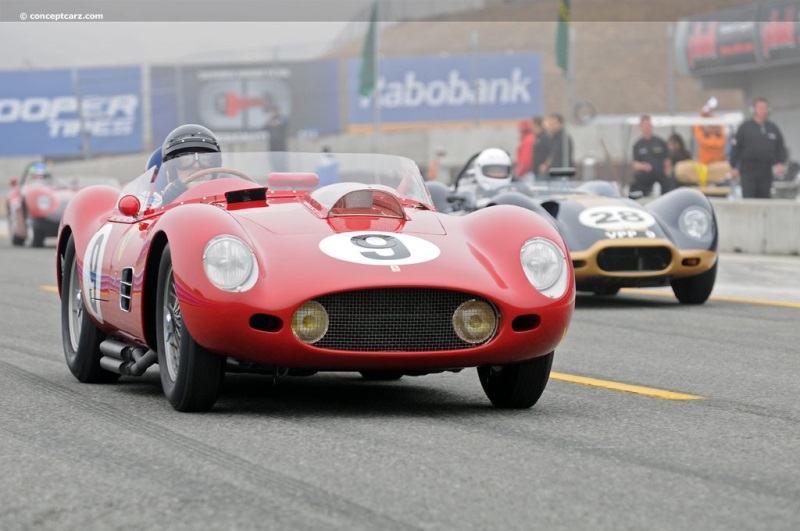When it was announced that the maximum engine displacement for the 24 Hours of LeMans and World Sports Car Championship was limited to 3 liters following the 1957 racing season, Ferrari responded with the 250 Testa Rossa (250 TR). Possessing many components from the tried-and-true 250 and 500 TR models, the 250 TR would achieve ten victories in World Sports Car Championship races including the 24 Hours of Le Mans in 1958, 1960, and 1961, the Targa Florio in 1958, the Pescara 4 Hours in 1961, the 1000 Km Buenos Aires in 1958 and 1960, and the 12 Hours of Sebring in 1958, 1959 and 1961.
Roadster by Fantuzzi
Chassis #: 0768
View info and historyWith the 250 TR, Ferrari captured the Constructor's World Sportscar Championship titles in 1958, 1960 and 1961. The Aston Martin DBR1 robbed Ferrari of the Championship title in 1959, and outpaced it at Le Mans, Nürburgring, and Tourist Trophy races that year. The DBR1 driven by Stirling Moss also placed first in 1958 at the 1000km Nürburgring.The history of the Testa Rossa began in 1956 with a customer request for a sports car capable of outpacing Maserati's 200 S. To that end, Ferrari built a two-liter, four-cylinder sports car with two-seater spider coachwork. Dubbed the 500 TR, its suspension and engine were based on the Tipo 500 Formula Two car. When the World Sportscar Championship ended the unlimited-displacement class following a tragic accident at the 1957 Mille Miglia, a new three-liter displacement was imposed. In response, Ferrari created the 250 TR, with its development by Scuderia Ferrari, and Carlo Chiti serving as chief designer. Ferrari engineers Andrea Fraschetti and, later Giotto Bizzarini, along with Pinin Farina, Fantuzzi, and Scaglietti provided contributions to the design. A total of 33 examples of all 250 TR types were built between 1957 and 1962 including 19 built for privateers and independent racing teams. Chassis Specification
Similar to the existing 4-cylinder 2.0-liter 500 TR, the 250 Testa Rossa received a tubular steel spaceframe chassis with a wheelbase size of 92.5-inches, four inches longer than the 500 TR. The independent front suspension used coil springs, with all customer cars having a live rear axle. The factory team cars built before 1960 had either the live or de Dion rear axle, while those built after 1960 used an independent rear setup.
Roadster by Fantuzzi
Chassis #: 0768
View info and historyFour-wheel drum brakes were used on 1957 and 1958 models, and even with the 'pontoon fender' coachwork, these brakes were subject to head-induced fade. For the 1959 season, Scuderia Ferrari replaced the drums with Dunlop discs.Colombo-designed 3.0L V12 Engine
The sophisticated and reliable Colombo-designed 3.0-liter V12 engine powering the 250 GT road and racing cars served as the basis for which Carlo Chiti and other Ferrari engineers used to power the 250 Testa Rossa. The 2,953cc engine had a 73 mm bore and 58.8mm stroke, six two-barrel Weber 38 DCN carburetors, two valves per cylinder, helical double-coil valve springs (smaller than the previously used torsion springs), and single overhead camshafts. The previous 250 engines had the cylinder heads secured with 18 studs, but the 250 TR had six additional studs, increasing the strength of the engine and improving head gasket sealing. Prior 250 designs had piston connecting rods forged from steel billet, while the TRs were machined, allowing them to be more stress resistant. The cam covers were painted bright red, earning the name 'Testa Rossa,' meaning 'Red Head.' The '250' in 250 TR represented the unitary displacement of the engine.The engine powering the 250 TR was designed Tipo 128 and its 300 horsepower at 7,000 RPM gave it a power/displacement ratio of 100 hp/liter. Initially, the engine was mated to a four-speed transmission, replaced in 1959 by a five-speed unit. The 250 TRs built for customers used a 250 GT-type transmission placed directly behind the engine. A few Scuderia Ferrari team cars were given rear-mounted transaxles for improved weight distribution. Body Designs
In a similar fashion to the four-cylinder Testa Rossas, all 250 TRs wore two-seater spider bodies.
Roadster by Fantuzzi
Chassis #: 0768
View info and historyThe first 250 TR produced was chassis number 0666TR, initially wearing enveloping bodywork by Scaglietti similar to that of the 500 TR, except with a large hood bulge. A re-design resulted in pontoon-style fenders reminiscent of a Formula 1 car. The headlights were set within the fenders and the protuberant central air intake was flanked by deep channels. This design promoted airflow towards the brake drums, helping alleviate the brake-fade issue by venting heat from the brakes and exhaust. The large bulge and air intake on the hood allowed clearance for the vertically oriented carburetors. The rear bodywork tapered gracefully to a pair of brake lights set into vertical fins. The 'pontoon fender' design was used on the early Scaglietti-bodied 250 TRs and on all cars sold new to privateers. The shape was visually stunning and appeared to be aerodynamically efficient, yet on high-speed circuits, it was discovered that the design generated a significant amount of aerodynamic drag and high-speed instability. To alleviate these issues, the bodywork was subsequently revised in a variety of styles from 1958 through 1961.1959 Ferrari 250 TR59
The 1959 Ferrari 250 TR was the first of the series to receive disc brakes and a five-speed transmission mounted directly behind the engine. The bodywork was revised by Pinin Farina with construction by Fantuzzi. The previous pontoon fenders and cutaway nose were replaced by an aerodynamic design with a clear hood bulge cover allowing a view of the carburetors. Chassis number 0766 was the prototype and test mule, and was followed by four other examples.The 1960 Ferrari TR60 and TRI60
After narrowly losing the 1959 World Sportscar Championship to Aston Martin, Ferrari updated the TR59 design resulting in the TR59/60. Two Ferrari Works Testa Rossas were built in the TR59/60 bodystyle with one distinguished by its four side pipes.
Roadster by Fantuzzi
Chassis #: 0774TR
View info and historyThe Ferrari TR59s had all blown their wet sump engines at the previous Le Man's race, so Ferrari updated all 250 TRs in 1960 with dry sump lubrication, allowing the engine to rest lower in the chassis, reducing the car's center of mass, and improving the handling. With the lower stance, the front profile became lower and more aerodynamic. A new, larger plexiglass windshield quickly proved to have several drawbacks including a larger surface area which increased drag. Examples fitted with an independent rear suspension and built in 1960 were designated as 250 TRI60. Examples devoid of the independent setup had conventional de Dion rear axles. 1959 cars that were updated to the 1960 specification (albeit without the independent rear suspension) are often designated as 250 TR59/60.The 1961 Ferrari 250 TRI61
The independent rear suspension became standard in 1961 and revisions to the bodywork included a gradually sloping windshield that wrapped around both sides of the cockpit, and a slightly concave Kamm tail. Instead of a single front air inlet, the TRI61 was split into two openings, giving it a 'sharknose' design that would later be used on other Ferrari sports racing cars such as the 246 SP and the 156 Formula 1 car. Wind tunnel testing revealed the twin intake design improved air penetration. The 1962 Ferrari 330 TRI/LM
The Ferrari 330 TRI/LM Spyder, with the 'LM' representing Le Mans, was the final iteration of the Testa Rossa, the final Ferrari racing sports car with a front-mounted engine, and the last front-engined car to win the 24 Hours of LeMans. The 'I' once again referenced its independent rear suspension and the '330' was for the Tipo 163 4.0 liter Colombo-designed V12 engine sourced from the 400 Superamerica. With modifications that included Testa Rossa cylinder heads, the engine produced 390 horsepower at 7,500 RPM, a significant increase from the 300 horsepower developed from the prior 3.0-liter Tipo 128 version.
Roadster by Fantuzzi
Chassis #: 0774TR
View info and historyOnly one example of the 330 TRI/LM was built, chassis number 0808 from a damaged 250 TRI60 (chassis number 0780TR). Chassis 0780TR began life as a 250 TRI/60 Fantuzzi Spyder that was badly damaged in 1960 at the Targa Florio. It was rebuilt and contested the 1960 24 Hours of Le Mans where it failed to finish. Its next race was in 1961 at the 12 Hours of Sebring before it returned to the Targa Florio, where it was once again damaged in a crash. Rebuilt, it placed second at the 1961 Nürburgring 1000km and 1961 24 Hours of Le Mans, it won at the 1961 Pescara 4 Hours.Returning to the Ferrari factory, 0780TR was rebuilt as the 330 TRI/LM (chassis 0808) and equipped with a 4.0-liter V12 engine and new bodywork. In this guise, it won the 1962 24 Hours of Le Mans. It returned to Le Mans in 1963 where it was in third place when it crashed and dropped out of the race. This would end its racing career. The Ferrari 250 TR
The Ferrari 250 TR had a very successful racing career, and throughout its existence, Ferrari engineers experimented with low-drag and stability-promoting aerodynamic bodywork. The results of these studies were incorporated into future models including the 250 GTO, and the 250, 275, and 330 P models. The most developed versions of the 250 TR were retained by the factory, earning Ferrari the Constructor's World Sportscar Championship titles in three out of the four seasons it contested.
by Daniel Vaughan | Sep 2022

Roadster by Fantuzzi
Chassis #: 0768
View info and history
Similar to the existing 4-cylinder 2.0-liter 500 TR, the 250 Testa Rossa received a tubular steel spaceframe chassis with a wheelbase size of 92.5-inches, four inches longer than the 500 TR. The independent front suspension used coil springs, with all customer cars having a live rear axle. The factory team cars built before 1960 had either the live or de Dion rear axle, while those built after 1960 used an independent rear setup.
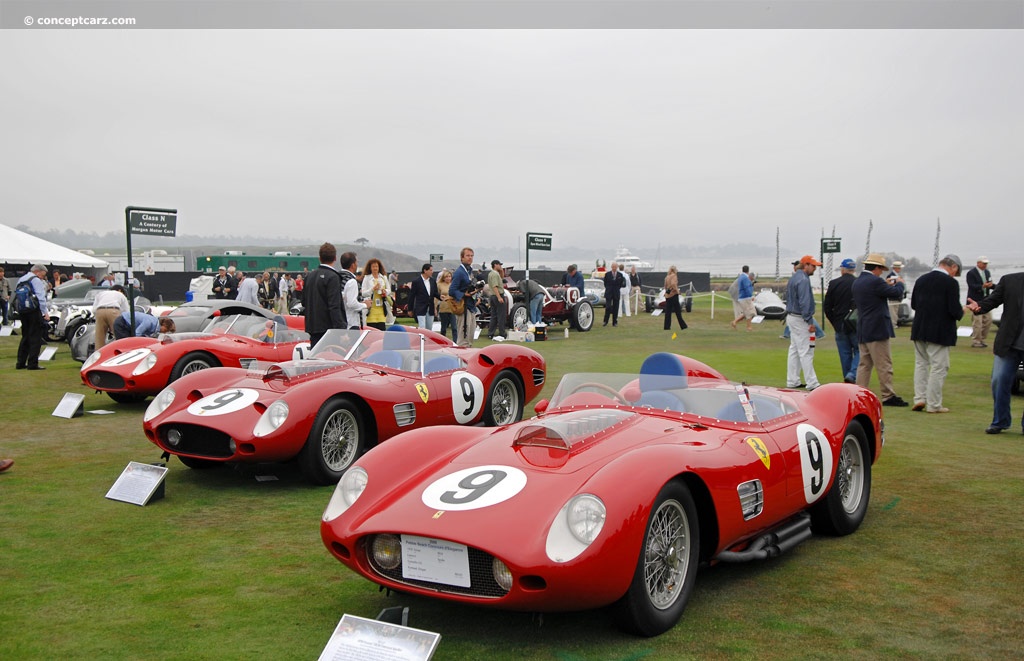
Roadster by Fantuzzi
Chassis #: 0768
View info and history
The sophisticated and reliable Colombo-designed 3.0-liter V12 engine powering the 250 GT road and racing cars served as the basis for which Carlo Chiti and other Ferrari engineers used to power the 250 Testa Rossa. The 2,953cc engine had a 73 mm bore and 58.8mm stroke, six two-barrel Weber 38 DCN carburetors, two valves per cylinder, helical double-coil valve springs (smaller than the previously used torsion springs), and single overhead camshafts. The previous 250 engines had the cylinder heads secured with 18 studs, but the 250 TR had six additional studs, increasing the strength of the engine and improving head gasket sealing. Prior 250 designs had piston connecting rods forged from steel billet, while the TRs were machined, allowing them to be more stress resistant. The cam covers were painted bright red, earning the name 'Testa Rossa,' meaning 'Red Head.' The '250' in 250 TR represented the unitary displacement of the engine.The engine powering the 250 TR was designed Tipo 128 and its 300 horsepower at 7,000 RPM gave it a power/displacement ratio of 100 hp/liter. Initially, the engine was mated to a four-speed transmission, replaced in 1959 by a five-speed unit. The 250 TRs built for customers used a 250 GT-type transmission placed directly behind the engine. A few Scuderia Ferrari team cars were given rear-mounted transaxles for improved weight distribution. Body Designs
In a similar fashion to the four-cylinder Testa Rossas, all 250 TRs wore two-seater spider bodies.
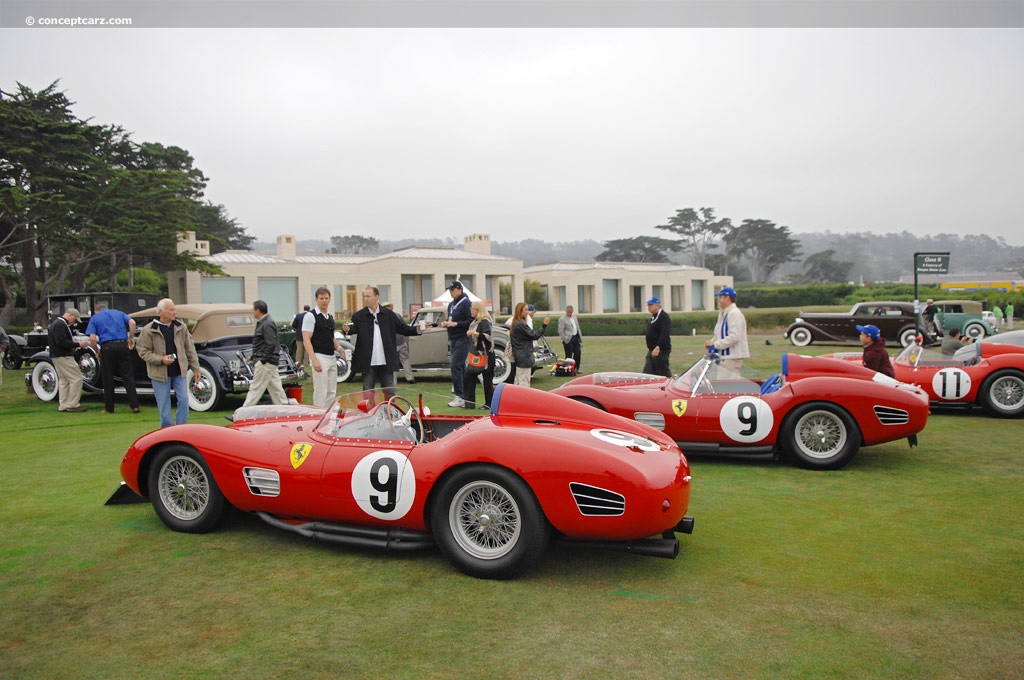
Roadster by Fantuzzi
Chassis #: 0768
View info and history
The 1959 Ferrari 250 TR was the first of the series to receive disc brakes and a five-speed transmission mounted directly behind the engine. The bodywork was revised by Pinin Farina with construction by Fantuzzi. The previous pontoon fenders and cutaway nose were replaced by an aerodynamic design with a clear hood bulge cover allowing a view of the carburetors. Chassis number 0766 was the prototype and test mule, and was followed by four other examples.The 1960 Ferrari TR60 and TRI60
After narrowly losing the 1959 World Sportscar Championship to Aston Martin, Ferrari updated the TR59 design resulting in the TR59/60. Two Ferrari Works Testa Rossas were built in the TR59/60 bodystyle with one distinguished by its four side pipes.
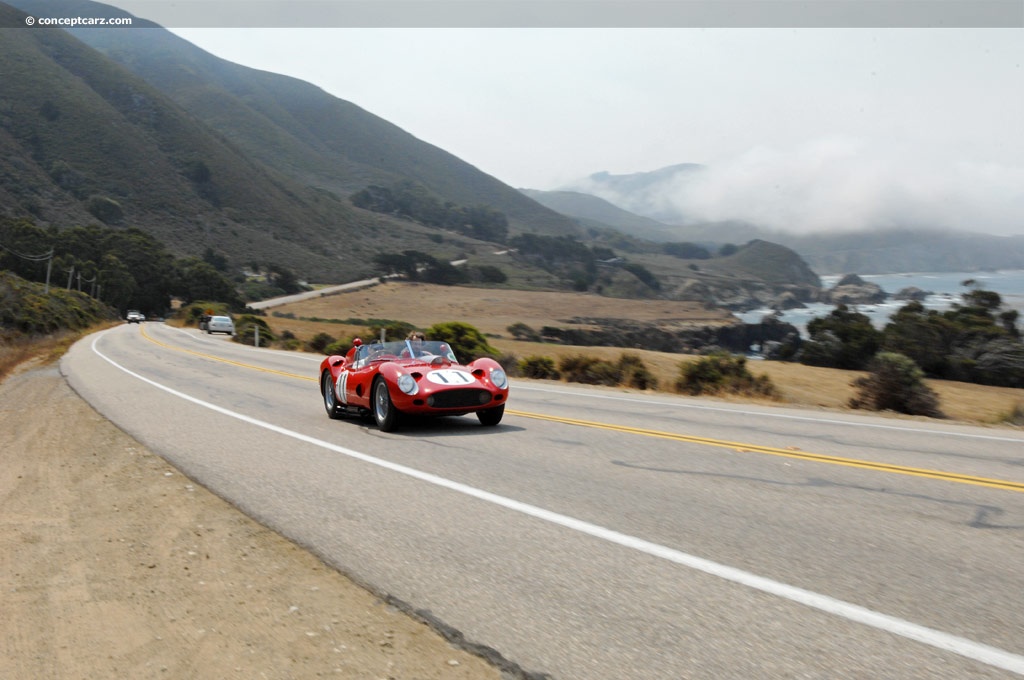
Roadster by Fantuzzi
Chassis #: 0774TR
View info and history
The independent rear suspension became standard in 1961 and revisions to the bodywork included a gradually sloping windshield that wrapped around both sides of the cockpit, and a slightly concave Kamm tail. Instead of a single front air inlet, the TRI61 was split into two openings, giving it a 'sharknose' design that would later be used on other Ferrari sports racing cars such as the 246 SP and the 156 Formula 1 car. Wind tunnel testing revealed the twin intake design improved air penetration. The 1962 Ferrari 330 TRI/LM
The Ferrari 330 TRI/LM Spyder, with the 'LM' representing Le Mans, was the final iteration of the Testa Rossa, the final Ferrari racing sports car with a front-mounted engine, and the last front-engined car to win the 24 Hours of LeMans. The 'I' once again referenced its independent rear suspension and the '330' was for the Tipo 163 4.0 liter Colombo-designed V12 engine sourced from the 400 Superamerica. With modifications that included Testa Rossa cylinder heads, the engine produced 390 horsepower at 7,500 RPM, a significant increase from the 300 horsepower developed from the prior 3.0-liter Tipo 128 version.
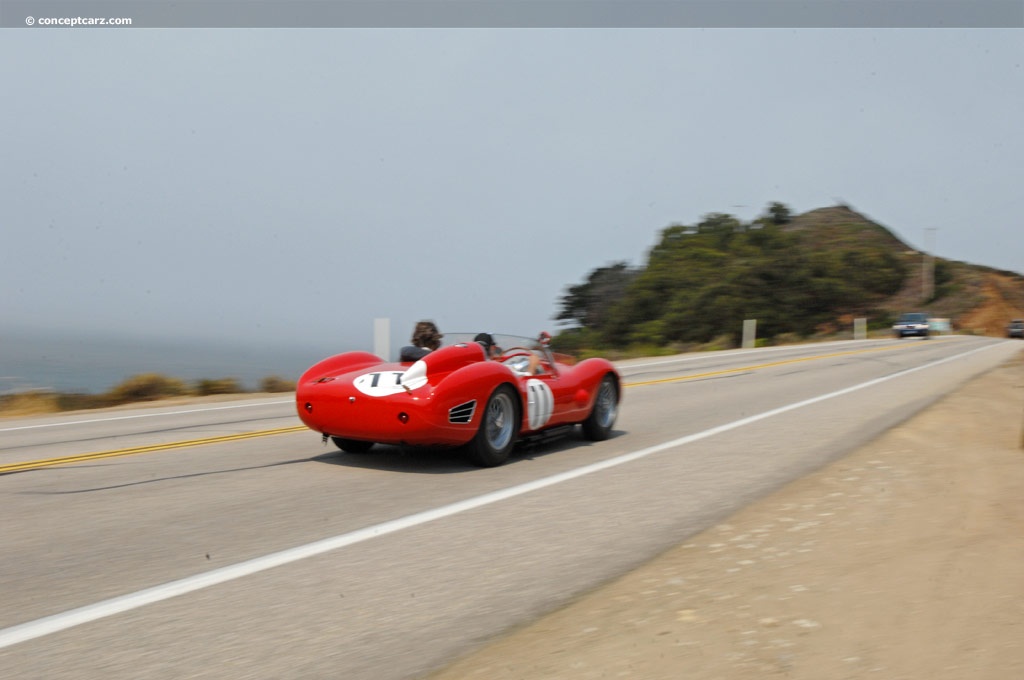
Roadster by Fantuzzi
Chassis #: 0774TR
View info and history
The Ferrari 250 TR had a very successful racing career, and throughout its existence, Ferrari engineers experimented with low-drag and stability-promoting aerodynamic bodywork. The results of these studies were incorporated into future models including the 250 GTO, and the 250, 275, and 330 P models. The most developed versions of the 250 TR were retained by the factory, earning Ferrari the Constructor's World Sportscar Championship titles in three out of the four seasons it contested.
by Daniel Vaughan | Sep 2022
Related Reading : Ferrari 250 Testarossa History
The Ferrari 250TR was produced from 1957 through 1958 during which time, only 19 examples were created. The pontoon fender body was designed by Scaglietti and the power was supplied through a Colombo 12-cylinder engine mounted at a sixty-degree angle and outfitted with six Weber 38 DCN carburetors. Power was sent to the rear wheels via a four-speed manual gearbox. With 300 horsepower, the 800 kg....
Continue Reading >>
Continue Reading >>
Related Reading : Ferrari 250 Testarossa History
In the post World War II era, the world was anxious to get back to racing. There were many interesting creations created during this time. Some were competitive, others were not. Sports Car Racing was becoming more and more popular as the years progressed. This progression came to an end in 1955, when the entire world was in-tuned to the worlds greatest racing stage, the 24 Hours of LeMans. The 24....
Continue Reading >>
Continue Reading >>
1959 Ferrari 250 TR59/60 Vehicle Profiles
Recent Vehicle Additions
Performance and Specification Comparison
250 TR59/60 Specification Comparison by Year
Year
Production
Wheelbase
Engine
Prices
Related Automotive News

Just Sold! Gooding & Company Proudly Announces the Recent Private Sale of Racing Veteran 0704 TR, the Only Unrestored Ferrari 250 Testa Rossa in Existence
The collector car market leader recently brokered the private sale of the sole unrestored Ferrari 250 Testa Rossa extant. The overall winner of the 1958 12 Hours of Sebring, 0704 TR is recognized as one of the most significant racing Ferraris of all...
1958 Targa Florio: Musso Commands the Heights
During the invasion of Sicily during the Second World War it would be the mountainous roads around the island that would pose the greatest hindrance to the advance of the British and American forces trying to breakthrough on their way, ultimately, to...
1958 12 Hours of Sebring: Collins and Hill Escort a Red-Head Home to Victory
In a matter of months Peter Collins would lay dying of wounds received in a violent crash at the Nurburgring during the German Grand Prix. While many would be holding their breaths and facing the cold-hard truth of another motor racing death, there would...

1959 12 Hours of Sebring: 12 Hours to Success
In 1961, Richie Ginther would join Giancarlo Baghetti, Willy Mairesse and Wolfgang von Trips to come away with a 2nd place overall finish in the 12 Hours of Sebring. Completing 208 laps, the Ferrari 250 Testa Rossa would finish two laps behind eventual...

1961 Targa Florio: Porsche Dominance, Ferrari Victorious
The first race held on the island of Sicily that included an automobile would take place between the car, a bicycle and a horse. Although the gentleman on the bicycle would drop out rather early due to leg cramps constantly going up and down on the mountainous...




























